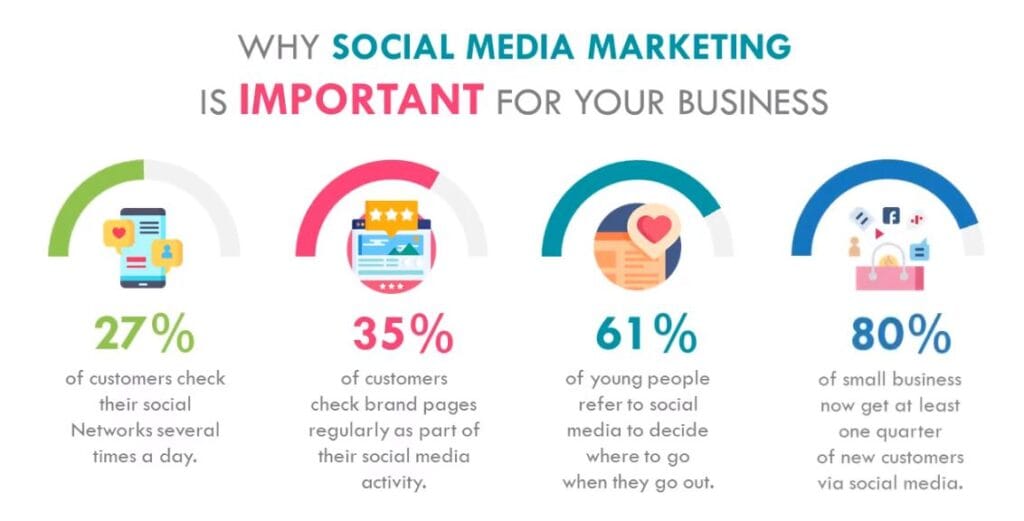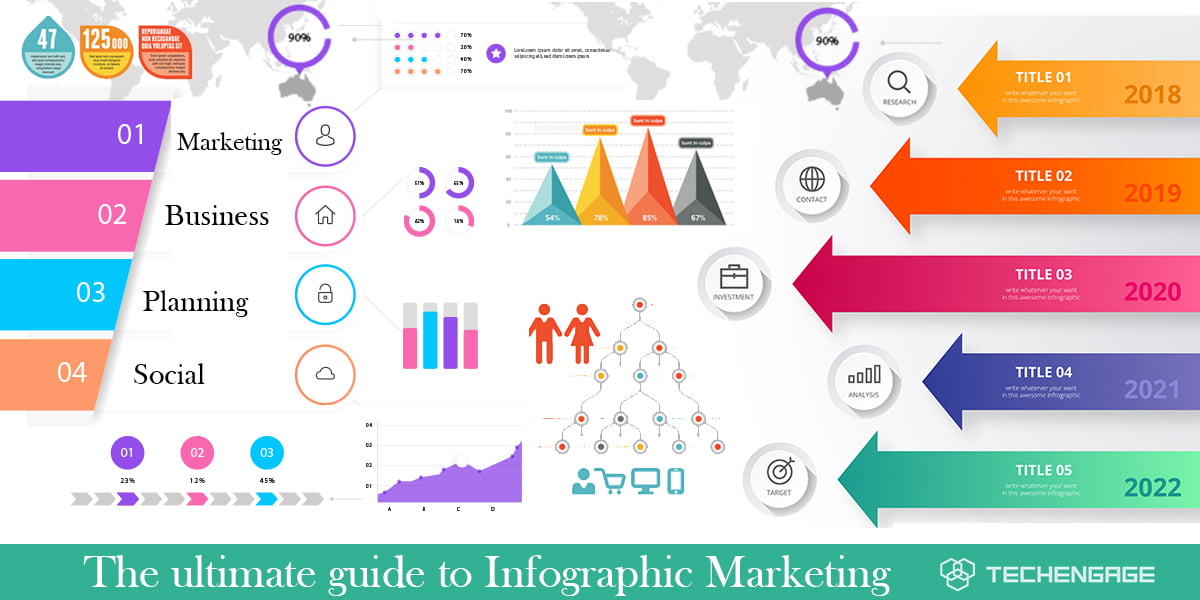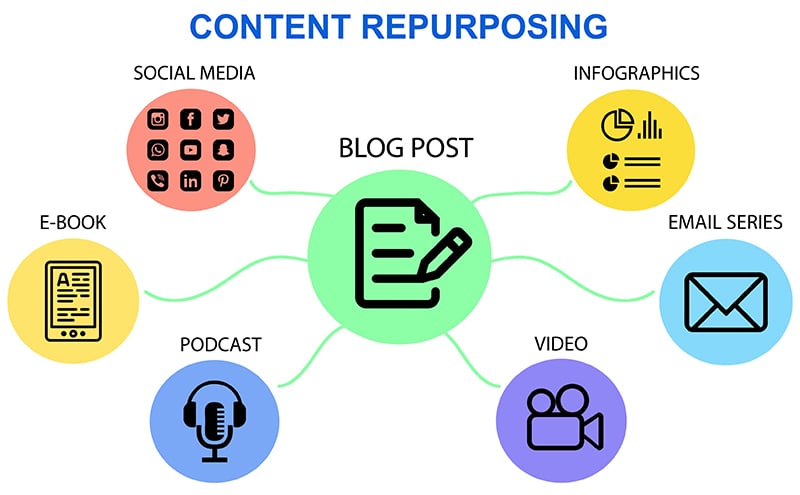30 Working Ways to Increase Website Traffic
Welcome to this comprehensive guide on 30 effective methods to increase website traffic. In today’s highly competitive online landscape, driving more visitors to your website is absolutely crucial for achieving success. Whether you operate a blog, e-commerce store, or corporate website, implementing the right strategies can significantly enhance your online visibility, user engagement, and ultimately lead to higher conversions.
Throughout this article, we will explore a variety of techniques that can assist you in attracting organic traffic, improving search engine rankings, and leveraging social media platforms to their fullest potential. From creating valuable content and optimizing it for search engines to harnessing the power of email marketing, we’ve got you covered with actionable insights that will undoubtedly help elevate your website’s traffic.
30 Working Ways to Increase Website Traffic
Let’s dive into the 30 effective strategies to increase website traffic and get your online presence thriving:
1. High-Quality Content Creation

The foundation of a successful website lies in its content. It is crucial to produce valuable, informative, and engaging content that resonates with your target audience. By doing so, you can attract more organic traffic and improve your search rankings. One effective way to enhance your content’s search engine optimization (SEO) is by naturally incorporating Latent Semantic Indexing (LSI) keywords into your articles.
When you create unique, interesting, and helpful content, it not only adds value to your website but also aids your SEO efforts. The more you optimize your content and attract site visits, the higher your website will rank on search engine results pages (SERPs). Additionally, posting informative content that holds value can increase the likelihood of repeat visitors. Readers will come to recognize your website as a reliable source of helpful information.
Since people often turn to Google to find specific, thorough, and accurate answers to their questions, it is vital for your content to provide those answers. Websites that feature blog content tend to generate 434% more search engine-indexed pages than those without it. Moreover, sites that publish more than 16 posts per month experience nearly 3.5 times more traffic than those with only zero to four articles.
when you care about the content you produce, maintain a regular posting schedule, and research what your audience wants to see, your website’s web traffic is likely to improve significantly. Valuable and relevant content that caters to your target audience’s needs will not only attract more visitors but also contribute to the long-term success of your website.
2. On-Page SEO Optimization

To increase your website’s search engine visibility and attract more organic traffic, it’s essential to optimize its on-page elements. Here are some key steps to achieve this:
Title Tags: Craft descriptive and keyword-rich title tags for each page on your website. Keep them concise (around 50-60 characters) and relevant to the content of the page.
Meta Descriptions: Write compelling meta descriptions for your pages, summarizing their content and encouraging users to click through. Aim for around 150-160 characters and include relevant keywords.
Headers: Use clear and hierarchical header tags (H1, H2, H3, etc.) to structure your content. Include keywords in the headers where appropriate, as it helps search engines understand the content’s organization.
URLs: Create clean and user-friendly URLs that are easy to read and understand. Incorporate relevant keywords into the URLs when possible, but avoid using long and complicated strings of characters.
Keyword Optimization: Integrate relevant keywords throughout your content naturally. Focus on user intent and provide valuable information, rather than keyword stuffing, which can harm your rankings.
Content Readability: Ensure that your content is easy to read and understand. Use short paragraphs, bullet points, and subheadings to break up large chunks of text.
User Experience (UX): Prioritize user experience throughout your website. Make it easy for visitors to navigate, find information, and take desired actions.
Mobile Optimization: Optimize your website for mobile devices, as an increasing number of users access the internet via smartphones and tablets.
Page Speed: Improve your website’s loading speed to enhance user experience and search engine rankings. Compress images, enable browser caching, and use a content delivery network (CDN) if needed.
Internal Linking: Create internal links between relevant pages on your website. This not only helps users navigate but also allows search engines to discover and index more of your content.
Image Optimization: Optimize images by using descriptive alt tags and reducing file sizes without compromising quality. This helps improve page load times and provides accessibility for visually impaired users.
Schema Markup: Implement schema markup to provide structured data to search engines, making it easier for them to understand your content and display rich snippets in search results.
Social Media Integration: Include social media sharing buttons on your content to encourage users to share and spread the word about your website.
By optimizing these on-page elements and incorporating relevant keywords wisely, you’ll improve your website’s search engine rankings and provide a better user experience for your visitors. Remember that high-quality content and a user-centric approach are fundamental to long-term success in attracting and retaining website traffic.
3. Mobile-Friendly Website Design

Having a mobile-friendly and responsive website is crucial in today’s digital landscape. With a growing number of users accessing the internet on their mobile devices, ensuring your website is optimized for mobile is essential for retaining visitors and enhancing search engine rankings.
Here are some key reasons why a mobile-friendly design is vital for your website’s success:
User Experience: Mobile-friendly websites offer a seamless and user-friendly experience for visitors using smartphones and tablets. A responsive design automatically adapts to different screen sizes, making it easier for users to navigate and consume content.
Search Engine Rankings: Search engines, like Google, prioritize mobile-friendly websites in their search results, especially for users searching on mobile devices. Having a mobile-friendly site can positively impact your SEO efforts and improve your chances of ranking higher in search engine results pages (SERPs).
Faster Load Times: Mobile-friendly websites are optimized for quicker loading on mobile devices, reducing bounce rates and increasing user engagement. Faster load times contribute to better user experience and higher search engine rankings.
Higher Conversion Rates: A mobile-friendly design can lead to increased conversion rates, as users are more likely to stay on your site and complete desired actions if the website is easy to use and navigate on their mobile devices.
Reach a Wider Audience: With the increasing use of mobile devices worldwide, having a mobile-friendly website allows you to reach and engage a broader audience, irrespective of their preferred devices.
Competitive Advantage: A mobile-friendly website gives you a competitive edge over competitors who may not have optimized their sites for mobile users. It shows that you value user experience and are willing to cater to your audience’s needs.
To ensure your website is mobile-friendly and responsive, consider the following practices:
- Use a responsive web design that automatically adjusts to different screen sizes.
- Test your website on various mobile devices to ensure proper functionality and appearance.
- Optimize images and other media to reduce load times on mobile devices.
- Implement touch-friendly elements, such as buttons and navigation menus, to enhance user interaction.
- Avoid using Flash, as it is not supported on many mobile devices.
- Enable viewport meta tags to ensure proper scaling on mobile screens.
- Make sure forms and call-to-action buttons are easily clickable and fillable on mobile devices.
By prioritizing a mobile-friendly design, you can create a positive user experience, improve search engine rankings, and ultimately drive more traffic to your website. It’s a critical step in today’s mobile-centric digital landscape.
4. Website Speed Optimization

Page loading speed plays a crucial role in both user experience and search engine rankings. To enhance your website’s loading time, consider implementing the following techniques:
- Compress Images: Optimize your images to reduce their file sizes without compromising on quality. Smaller image sizes will lead to faster loading times.
- Enable Browser Caching: Configure your website to utilize browser caching. This way, when users visit your site, certain elements will be stored in their browser cache. Upon subsequent visits, these elements can be loaded from the cache, speeding up the loading process.
- Leverage Content Delivery Networks (CDNs): Utilize CDNs to distribute your website’s content across multiple servers located in different geographical locations. CDNs serve content from a server that is physically closer to the user, reducing latency and improving loading times.
By implementing these practices, you can significantly improve your website’s loading speed, resulting in better user experiences and potentially higher search engine rankings.
5. Keyword Research and Targeting

Conducting thorough keyword research is essential to identify high-traffic and low-competition keywords that are relevant to your niche. By creating content around these keywords, you can increase your chances of ranking higher in search engine results. Here’s a step-by-step guide to performing effective keyword research:
- Understand Your Niche: Begin by gaining a clear understanding of your niche or the topic you want to focus on. Know your target audience and the topics they are interested in.
- Brainstorm Seed Keywords: Come up with a list of seed keywords that are directly related to your niche. These are the primary keywords that will form the basis of your research.
- Use Keyword Research Tools: Utilize keyword research tools like Google Keyword Planner, Ahrefs, SEMrush, or Ubersuggest to find keyword ideas and get data on search volume, competition, and related terms.
- Analyze Search Volume and Competition: Look for keywords with a decent search volume (high-traffic) but relatively low competition. This means that many people are searching for these terms, but not many websites are targeting them, giving you a better chance of ranking higher.
- Long-Tail Keywords: Consider incorporating long-tail keywords, which are more specific phrases with lower search volume but also lower competition. These can be valuable for attracting more targeted and engaged traffic.
- Focus on User Intent: Choose keywords that match the user’s intent. Understand what the searcher is looking for when using a particular keyword and create content that fulfills that intent.
- Organize and Prioritize Keywords: Categorize your keywords based on relevance and search volume. Prioritize the most valuable ones that align well with your content strategy.
- Create High-Quality Content: Develop valuable, informative, and engaging content around your chosen keywords. Ensure that your content provides relevant information and addresses the needs of your target audience.
- Monitor and Optimize: Keep track of your content’s performance in search results. Monitor how your selected keywords are performing, and be open to making adjustments to your content strategy as needed.
By following these steps, you can effectively use keyword research to identify the right keywords for your content, which will improve your chances of ranking higher in search engine results and attracting more organic traffic to your website.
6. Guest Blogging

Collaborating with other websites and blogs in your industry to publish guest posts can be a highly effective strategy to expand your reach, tap into a new audience, and build valuable backlinks to your website. Here’s how you can make the most of guest posting:
- Identify Relevant and Authoritative Websites: Look for websites and blogs in your industry that have a significant audience and a good reputation. These should be platforms where your target audience hangs out.
- Research Guest Posting Guidelines: Before reaching out to a website, thoroughly read their guest posting guidelines. Each site may have specific requirements and guidelines for submitting guest posts.
- Offer High-Quality and Valuable Content: When pitching guest post ideas, ensure that your content is valuable, informative, and relevant to the host website’s audience. Provide unique insights and actionable information that will benefit their readers.
- Personalize Your Outreach: When reaching out to potential websites for guest posting opportunities, personalize your emails. Show that you are familiar with their content and explain why your guest post would be a valuable addition to their platform.
- Include Backlinks to Your Website: Within your guest post, include relevant and contextual backlinks to your own website. These backlinks can direct readers to related content on your site, helping to improve your website’s authority and SEO rankings.
- Engage with the Audience: Once your guest post is published, be proactive in engaging with the readers in the comments section. Answer questions, respond to feedback, and establish yourself as an authority in your field.
- Promote the Guest Post: Share the guest post across your own social media channels and email newsletter to drive traffic back to the host website and showcase your expertise to your audience.
- Nurture Relationships: Building strong relationships with other website owners and bloggers in your industry can lead to more guest posting opportunities in the future. Maintain these connections for potential collaborations down the road.
Guest posting can be a mutually beneficial strategy, allowing you to reach new audiences, build authority in your niche, and acquire valuable backlinks. By consistently creating high-quality guest posts and collaborating with relevant websites, you can enhance your online presence and attract more traffic to your own site.

Social media platforms are powerful tools to promote your content, engage with your audience, and build a strong online community. Here are some effective strategies to leverage the power of social media:
- Share Valuable Content: Regularly post high-quality and valuable content that aligns with your target audience’s interests and needs. This could include blog posts, articles, infographics, videos, and other relevant resources.
- Utilize Different Platforms: Identify the social media platforms where your target audience is most active and present. Focus your efforts on those platforms to maximize your reach and engagement.
- Create a Content Calendar: Plan and organize your social media posts using a content calendar. Consistency is key, so schedule posts at optimal times to reach the highest number of followers.
- Use Visuals: Incorporate eye-catching visuals such as images, graphics, and videos to make your content more appealing and shareable.
- Engage with Your Audience: Respond to comments, messages, and mentions from your followers. Engage in conversations, answer questions, and show appreciation for their feedback.
- Run Contests and Giveaways: Organize social media contests and giveaways to encourage user participation and attract more followers. Make sure the prizes are relevant to your niche and of value to your audience.
- Encourage User-Generated Content (UGC): Request and showcase UGC from your followers. This not only increases engagement but also builds a sense of community and trust around your brand.
- Monitor Analytics: Keep track of social media analytics to understand what types of content perform well and resonate with your audience. Use this data to refine your social media strategy.
- Collaborate with Influencers: Partner with influencers or other relevant accounts in your industry to reach a broader audience and gain credibility.
- Stay Consistent and Authentic: Be consistent in your branding and messaging across all social media platforms. Be genuine and authentic in your interactions to build trust and loyalty with your audience.
Remember that social media is not just a promotional tool; it’s a place to connect with your audience and build relationships. By sharing valuable content, fostering engagement, and creating a sense of community, you can harness the power of social media to boost your brand’s visibility and grow your online presence.
8. Email Marketing Campaigns

Building an email list and utilizing email marketing can be an effective way to drive repeat traffic, nurture relationships with your audience, and keep them engaged. Here are some key steps to make the most of email marketing:
- Create a Sign-Up Form: Add a sign-up form on your website or landing pages to encourage visitors to subscribe to your email list. Offer incentives like free resources, exclusive content, or discounts to entice them to join.
- Segment Your Email List: Categorize your subscribers based on their interests, preferences, or behaviors. Segmenting your list allows you to send more targeted and personalized content, improving engagement.
- Plan a Content Strategy: Develop a content strategy for your email newsletters. Decide on the frequency of your emails and plan what type of content you will send – whether it’s blog updates, product promotions, educational content, or curated industry news.
- Craft Compelling Subject Lines: Your subject lines are crucial as they determine whether your emails get opened or not. Create attention-grabbing and relevant subject lines that entice subscribers to click and read the content.
- Provide Valuable Content: Ensure that your email content provides value to your subscribers. Offer helpful tips, industry insights, exclusive offers, or entertaining content that keeps them engaged and eager to open your emails.
- Include Call-to-Actions (CTAs): Encourage your subscribers to take action with clear and compelling CTAs. Whether it’s to read an article, visit your website, or make a purchase, CTAs prompt engagement.
- Optimize for Mobile: Many people check emails on their mobile devices, so ensure your emails are mobile-responsive to provide a seamless experience for all users.
- Test and Analyze: A/B test different elements of your emails, such as subject lines, content, and CTAs, to see what resonates best with your audience. Monitor email analytics to track open rates, click-through rates, and conversions.
- Avoid Spam Traps: Be mindful of spam filters and avoid using spam-triggering words and practices that could harm your email deliverability.
- Respect Unsubscribes: Provide an easy way for subscribers to opt-out if they wish to unsubscribe from your emails. Respecting their preferences builds trust and maintains a positive brand image.
Email marketing allows you to stay connected with your audience, nurture leads, and drive repeat traffic to your website or products. When done right, it can be a powerful tool for fostering customer loyalty and boosting your overall online presence.
9. Video Marketing

Creating compelling video content is a great way to boost website traffic and engage your audience on platforms like YouTube and social media. Here’s a step-by-step guide on how to create and share compelling video content:
- Define Your Goals: Start by clarifying your objectives. Are you aiming to drive more traffic to your website, increase brand awareness, or engage with your audience on a deeper level? Knowing your goals will help shape your video content strategy.
- Audience Research: Understand your target audience’s preferences, interests, and pain points. This information will guide your content creation and help you tailor your videos to resonate with your viewers.
- Content Planning: Brainstorm video ideas that align with your goals and audience. Consider creating a content calendar to keep your video production consistent.
- Scripting and Storyboarding: Write a script or outline for your video. Storyboarding can help visualize the flow and visuals of your video. Make sure your content is engaging and delivers value to your audience.
- Equipment and Setup: Invest in good-quality equipment such as cameras, microphones, and lighting to ensure professional-looking videos. Create a dedicated filming space with appropriate background and aesthetics.
- Filming and Editing: Shoot your video, ensuring good audio and video quality. Edit your video to make it visually appealing, engaging, and concise. Use video editing software like Adobe Premiere Pro, Final Cut Pro, or even free options like iMovie or DaVinci Resolve.
- Branding and Thumbnails: Incorporate your brand elements into your video, such as logos, colors, and fonts. Create attention-grabbing video thumbnails to entice viewers to click on your content.
- Optimize for SEO: Use relevant keywords in your video title, description, and tags to improve discoverability on platforms like YouTube. Include a call-to-action and links to your website in the video description.
- Engage with Your Audience: Respond to comments and engage with your viewers. Building a community around your videos can lead to more shares and increased website traffic.
- Promotion: Share your video on multiple platforms, including YouTube, Facebook, Twitter, Instagram, and your website. Leverage email marketing and collaborations with influencers or industry partners to expand your reach.
- Analytics and Improvement: Use analytics tools provided by platforms to track video performance. Pay attention to metrics like watch time, click-through rate, and audience retention. Use this data to refine your content strategy and improve future videos.
- Consistency and Persistence: Consistency is key to building an audience. Keep creating and sharing quality video content regularly to maintain engagement and grow your viewership over time.
Remember, creating compelling video content is an ongoing process. Continuously assess what works best for your audience and adapt your strategy accordingly. With dedication and a focus on delivering value, you can use video content to increase website traffic and enhance user engagement effectively.
10. Influencer Partnerships

Collaborating with influencers and industry experts is a powerful strategy to expand your website’s visibility and reach a broader audience. Here’s how you can effectively partner with influencers:
- Identify the Right Influencers: Research and identify influencers and industry experts who align with your niche, brand, and target audience. Look for individuals whose followers would likely be interested in your content or products.
- Engage and Build Relationships: Before reaching out, engage with the influencers on social media by liking, commenting, and sharing their content. Build a genuine relationship with them to establish trust and rapport.
- Craft a Personalized Pitch: When reaching out to influencers, send them a personalized message or email explaining why you’d like to collaborate and how it could benefit both parties. Highlight the value you can offer, whether it’s exclusive content, product samples, or compensation.
- Outline Clear Expectations: Be transparent about your expectations and what you’d like the influencer to do. This could include creating sponsored content, sharing your website links, or participating in a joint project.
- Co-create Content: Collaborate with the influencer to co-create engaging content that resonates with their audience and showcases your brand or website. Allow the influencer to add their unique perspective and creativity.
- Leverage Multiple Platforms: Encourage influencers to share the content on multiple platforms, such as YouTube, Instagram, TikTok, or their blog, to maximize visibility.
- Measure and Analyze Results: Track the performance of the collaboration using metrics like website traffic, social media engagement, and conversion rates. Analyze the data to determine the ROI and effectiveness of the partnership.
- Compensate Fairly: If you’re offering compensation, ensure that it’s fair and aligns with the influencer’s reach and impact. Compensation can be monetary, free products, or a combination of both.
- Promote the Collaboration: Promote the influencer collaboration on your website, social media, and email marketing campaigns. Highlight the content they’ve created and how it benefits your audience.
- Maintain Ongoing Relationships: Building long-term relationships with influencers can lead to continued collaborations and a stronger online presence. Stay in touch, provide feedback, and support their content even when you’re not actively collaborating.
- Comply with Regulations: Depending on your region, there may be legal regulations regarding influencer collaborations, such as disclosure requirements. Ensure that your collaborations adhere to these regulations.
- Adapt and Iterate: Based on the results and feedback from influencers and their audiences, adapt your influencer marketing strategy. Continuously refine your approach to maximize its effectiveness.
Remember that influencer collaborations are most successful when they are authentic and mutually beneficial. Choose influencers who genuinely resonate with your brand and values, as this authenticity will translate into better engagement and increased website visibility among their followers.
11. Quora Marketing

Participating actively on Quora is an excellent way to establish yourself as an authority in your niche and drive traffic to your website. Here’s a step-by-step guide on how to effectively use Quora for this purpose:
- Profile Optimization: Create a professional and informative Quora profile. Use a clear profile picture, write a concise bio that highlights your expertise, and include links to your website and social media profiles.
- Niche Identification: Focus on a specific niche or area of expertise related to your website’s content. This will help you attract an audience genuinely interested in your knowledge.
- Keyword Research: Identify relevant keywords and topics in your niche that people frequently ask questions about on Quora. Use these keywords to find questions to answer.
- Answering Questions: Search for questions within your niche and provide thoughtful, detailed, and helpful answers. Always prioritize quality over quantity. Address the question thoroughly and provide value in your responses.
- Cite Your Expertise: When answering questions, mention your qualifications or experience in the field to establish credibility. Avoid overly promotional language; instead, let your knowledge shine through.
- Link to Your Website: Include links to relevant articles or resources on your website when it adds value to your answer. Ensure that the links are genuinely helpful and not overly promotional. Make it clear how the link benefits the reader.
- Engage with the Community: Upvote and comment on other users’ answers, engage in discussions, and follow topics related to your niche. Building a presence within the community can help increase your visibility.
- Consistency is Key: Regularly answer questions on Quora to maintain your presence and authority. Consistency in your contributions will gradually build your reputation.
- Track Performance: Monitor the performance of your answers. Check the number of views, upvotes, and comments your answers receive. This data can help you refine your approach.
- Avoid Plagiarism: Always provide original and unique content in your answers. Plagiarism can harm your reputation on Quora and may result in penalties.
- Follow Quora Guidelines: Familiarize yourself with Quora’s content policies and guidelines to ensure your answers comply with their rules.
- Engage Beyond Quora: Share your Quora answers on your social media profiles and website to further promote your expertise and drive traffic.
- Network with Influencers: Connect with influencers and experts in your niche on Quora. Engaging with them can help you gain visibility and credibility.
Remember that Quora is a platform for sharing knowledge and expertise. While promoting your website is a valuable aspect of your participation, the primary focus should be on providing genuinely helpful and informative answers to users’ questions. Over time, your efforts on Quora can help establish you as an authority in your field and drive organic traffic to your website.
12. Conduct Webinars and Live Events

Hosting webinars and live events is an excellent way to engage with your audience in real-time, provide valuable insights, and drive traffic to your website. Here’s a step-by-step guide on how to effectively host webinars and live events:
- Define Your Goals: Start by clarifying your objectives for the webinar or live event. Are you aiming to educate your audience, promote a product or service, or build your brand’s authority? Knowing your goals will guide your planning.
- Choose a Topic: Select a relevant and compelling topic that aligns with your expertise and audience’s interests. Ensure it provides value and addresses their pain points or questions.
- Select a Platform: Choose a reliable webinar or live streaming platform such as Zoom, Webex, GoToWebinar, or platforms like Facebook Live, YouTube Live, or Twitch, depending on your audience’s preferences.
- Set a Date and Time: Schedule your webinar or live event at a time that accommodates your target audience’s availability. Consider different time zones if your audience is global.
- Promote Your Event: Create promotional materials, including eye-catching graphics, social media posts, email invitations, and website announcements. Use a registration page or landing page on your website to collect RSVPs and gather participant information.
- Prepare Content: Develop a structured and engaging presentation or agenda for your event. Include valuable insights, tips, and actionable takeaways that will benefit your audience.
- Engage with Participants: During the live event, actively engage with your audience by answering questions, conducting polls, and encouraging discussion in the chat or comments section. Make the event interactive and dynamic.
- Promote Your Website: Mention your website and relevant resources throughout the webinar or live event. Share links to specific pages or content on your site that complement the topic being discussed.
- Record and Repurpose: Record the webinar or live event so that you can repurpose it later as on-demand content. This allows you to continue driving traffic to your website even after the live event has ended.
- Follow Up: After the event, send a follow-up email to participants. Express gratitude for their attendance, provide a recap of key points, and include additional resources from your website.
- Gather Feedback: Encourage participants to provide feedback on the event through surveys or post-event discussions. Use this feedback to improve future webinars and events.
- Repeat and Iterate: Host webinars and live events regularly to keep your audience engaged and returning to your website for more valuable content. Continuously refine your approach based on participant feedback and performance data.
- Collaborate and Guest Speakers: Consider collaborating with guest speakers or experts in your field to increase the appeal and reach of your events.
Webinars and live events provide a unique opportunity to connect with your audience in a personal and interactive way. By offering valuable insights and directing participants to your website for further resources, you can effectively drive traffic and establish yourself as an authority in your niche.
13. Infographics and Visual Content

Creating informative infographics and other visual content is a highly effective way to engage your audience, increase social media shares, and drive traffic to your website. Here’s how to create and leverage visual content:
- Identify Key Information: Determine the key information or data you want to convey through your infographic. It should be relevant to your niche and audience’s interests.
- Choose a Visual Style: Select a visual style that aligns with your brand and message. Ensure that it is visually appealing and easy to understand.
- Gather Data and Content: Collect the data, statistics, and content you plan to include in your infographic. Make sure the information is accurate and from reputable sources.
- Design the Infographic: Use graphic design software like Adobe Illustrator, Canva, or Piktochart to create your infographic. Pay attention to layout, color schemes, fonts, and visuals to make it engaging.
- Simplify and Visualize Data: Transform complex data into easy-to-understand visuals. Use charts, graphs, icons, and images to illustrate your points.
- Add a Catchy Title: Include a compelling and concise title at the top of your infographic. The title should give viewers an idea of what to expect.
- Cite Sources: If you’re using data or statistics from external sources, provide proper citations on the infographic. This adds credibility to your content.
- Make it Shareable: Ensure your infographic is shareable on social media by optimizing its dimensions and file size. Commonly accepted formats include JPEG and PNG.
- Include Your Website URL: Add your website URL or a QR code linking to your website at the bottom of the infographic. This makes it easy for viewers to visit your site for more information.
- Promote on Social Media: Share your infographic on your social media platforms. Write a catchy caption or teaser to encourage sharing. Use relevant hashtags to increase visibility.
- Leverage Visual Content Platforms: Consider using platforms like Pinterest and Instagram, which are highly visual and share-friendly, to promote your infographics.
- Collaborate and Tag Influencers: Collaborate with influencers in your niche by asking them to share your infographic with their followers. Tag them when you post the infographic to increase the chances of them seeing and sharing it.
- Track Performance: Use analytics tools to track the performance of your infographic. Monitor shares, likes, comments, and clicks to see how well it’s driving traffic to your website.
- Repurpose and Update: Over time, consider repurposing your infographic content into other formats, such as blog posts, videos, or slide presentations. Update infographics as new data becomes available to keep them relevant.
- Encourage Embedding: Provide an option for viewers to embed your infographic on their websites or blogs with proper attribution. This can lead to backlinks and increased traffic.
Creating shareable and linkable infographics is a valuable content marketing strategy. By providing valuable information in an engaging visual format, you can not only drive traffic to your website but also establish yourself as a trusted source of information in your niche.

Submitting your best content to social bookmarking websites like Reddit, Digg, and StumbleUpon (now known as Mix) can indeed generate significant traffic to your website if done effectively. Here are some steps to make the most of these platforms:
- Choose the Right Subreddits and Categories: On Reddit, for example, find subreddits (topic-specific communities) or categories on Digg and Mix that are relevant to your content. It’s crucial to match your content with the interests of the users in these communities.
- Participate and Build Trust: Before sharing your own content, participate in discussions, comment on other posts, and upvote valuable content. Building a positive reputation in these communities can make your submissions more well-received.
- Follow Community Rules: Each platform has its own rules and guidelines. Familiarize yourself with these rules and adhere to them strictly. Failure to do so can result in your content being removed or your account being banned.
- Craft an Engaging Title: Create a compelling and descriptive title for your submission. It should grab the attention of users and clearly convey what your content is about.
- Provide Value in the Submission: When submitting your content, include a concise and informative description. Explain why it’s valuable or relevant to the community. Avoid overly promotional language.
- Use Relevant Tags and Categories: Tag your content appropriately on platforms that support tags or categories. This helps users find your content when searching for specific topics.
- Timing Matters: The timing of your submission can impact its visibility. On platforms like Reddit, it’s often best to post during peak activity hours for your target subreddit. Timing can vary by subreddit, so research accordingly.
- Engage with Comments and Feedback: After you’ve submitted your content, actively engage with comments and feedback from users. Respond to questions, acknowledge feedback (positive or negative), and provide additional context if needed.
- Monitor Performance: Keep an eye on the performance of your submissions. Track metrics like upvotes, comments, and clicks to your website. This data can help you refine your strategy for future submissions.
- Don’t Overdo It: Avoid spamming these platforms with excessive self-promotion. Balance your submissions with other valuable contributions and aim for quality over quantity.
- Encourage Sharing: Include social sharing buttons on your website to make it easy for visitors to share your content on these platforms. You can also politely ask your audience to share your content if they find it valuable.
- Build Relationships: Over time, build relationships with other users who share similar interests. Collaborate with them on content or share each other’s work when relevant.
Remember that success on social bookmarking websites takes time and patience. It’s important to approach these platforms as a member of the community rather than just a promoter. By providing value and engaging genuinely, you can tap into the potential of these platforms to drive traffic to your website.
15. Collaborate with Other Website Owners

Building relationships with other website owners and exploring cross-promotion opportunities is a smart strategy to expand your reach, improve your website’s SEO, and tap into new audiences. Here’s how you can effectively engage in cross-promotion:
- Identify Potential Partners: Look for websites in your niche or related industries that have a similar target audience but aren’t direct competitors. These can be blogs, businesses, or influencers.
- Engage and Connect: Start by genuinely engaging with their content. Leave thoughtful comments, share their posts on social media, and establish a rapport. Building a positive relationship is the first step.
- Reach Out with a Proposal: Once you’ve established a connection, reach out to potential partners with a proposal for cross-promotion. Explain how it could be mutually beneficial, highlighting the value you can offer.
- Co-create Content: Collaborate on content projects such as guest blog posts, co-authored articles, podcasts, or videos. Ensure that the content aligns with both parties’ audiences and provides value.
- Backlink Exchange: Include backlinks to each other’s websites within the content you create together. These can be natural and contextually relevant links that enhance the user experience.
- Share on Social Media: Promote the co-created content on your respective social media platforms. This amplifies the reach and exposure to both audiences.
- Email Newsletter Inclusion: If both you and your partner have email newsletters, consider including mentions or links to each other’s content in your newsletters. This exposes your content to a targeted audience.
- Collaborative Giveaways and Contests: Host joint giveaways or contests that encourage participation from both of your audiences. This can be an effective way to boost engagement and visibility.
- Monitor and Analyze Results: Keep track of the performance of your cross-promotion efforts. Use analytics tools to measure the impact on website traffic, engagement, and conversion rates.
- Continuously Nurture Relationships: Maintain a positive and professional relationship with your partners. Continue to explore new opportunities for collaboration and support their content as well.
- Diversify Partnerships: Don’t limit yourself to one partner. Explore multiple cross-promotion opportunities to reach a broader audience.
- Be Transparent: Always be transparent with your audience. Let them know when content is co-created or part of a cross-promotion effort. Transparency builds trust.
- Adapt and Optimize: Based on the results and feedback, adapt your cross-promotion strategies to improve effectiveness over time.
Cross-promotion is a win-win strategy that can help you expand your online presence, boost website traffic, and connect with new audiences.
16. Utilize Online Forums

Engaging in online forums and discussion boards relevant to your niche is a great way to establish your authority, connect with your target audience, and drive traffic to your website. Here’s how to effectively participate in online forums:
- Identify Relevant Forums: Research and identify forums, discussion boards, and online communities that are active and relevant to your niche. Popular options include Reddit, Quora, industry-specific forums, and social media groups.
- Create a Detailed Profile: Create a profile on each forum with accurate information and a professional image. Fill out your bio or profile description to briefly introduce yourself and your expertise.
- Lurk and Learn: Spend some time initially observing the discussions and learning about the forum’s culture, rules, and common topics of interest. This will help you understand the community dynamics.
- Provide Value with Quality Responses: When you start participating, focus on providing thoughtful, well-researched, and helpful responses to questions and discussions. Offer solutions, share your expertise, and aim to genuinely help others.
- Use Proper Etiquette: Be respectful, polite, and constructive in your interactions. Avoid confrontations, arguments, or spammy behavior. Follow each forum’s guidelines and rules.
- Include Links Sparingly: While it’s acceptable to include links to your website when they provide additional value or context to your responses, avoid over-promotion. Ensure that the links are genuinely helpful and relevant to the discussion.
- Contextual Linking: When including links, do so in a way that adds value to the conversation. Explain how the link can help the user and provide a brief description.
- Answer Questions Thoroughly: When responding to questions, aim to provide comprehensive and detailed answers. If the answer is extensive, consider directing users to relevant articles or resources on your website.
- Engage Actively: Regularly participate in discussions, answer questions, and engage with other forum members. Building a presence and reputation within the community takes time.
- Track Your Responses: Keep track of your forum responses and monitor any clicks or traffic generated from the links to your website. This will help you measure the impact of your participation.
- Private Messaging and Networking: Engage in private conversations with fellow forum members when appropriate. This can lead to valuable networking opportunities and collaborations.
- Stay Updated and Consistent: Continuously monitor the forums for new discussions and topics. Consistency in your engagement will help you build a strong presence over time.
- Respect User Privacy: Be mindful of user privacy and confidentiality. Avoid sharing personal or sensitive information without permission.
Engaging in online forums can be a long-term strategy to establish yourself as an authority in your niche and drive organic traffic to your website. By providing value, building relationships, and following forum etiquette, you can leverage these platforms to connect with your target audience effectively.
17. Run Contests and Giveaways

Organizing contests and giveaways is a proven strategy to boost user participation, increase website traffic, and enhance social media engagement. Here’s a step-by-step guide on how to plan and execute effective contests and giveaways:
- Set Clear Objectives: Define your goals for the contest or giveaway. Are you aiming to increase website traffic, grow your social media following, promote a specific product or service, or collect user-generated content? Knowing your objectives will help shape your strategy.
- Choose the Prize: Select a prize that is attractive to your target audience. It should be relevant to your niche and something that will genuinely interest participants.
- Select Entry Mechanisms: Decide how participants can enter the contest or giveaway. Common entry mechanisms include liking, sharing, commenting, tagging friends, subscribing to your newsletter, or submitting user-generated content.
- Set Clear Rules and Guidelines: Create a set of clear and concise rules for your contest or giveaway. Outline eligibility criteria, entry deadlines, how winners will be chosen, and how the prize will be distributed.
- Promote Your Contest: Use your website, social media channels, email newsletters, and any other relevant platforms to promote the contest or giveaway. Create eye-catching graphics and posts to attract attention.
- Leverage Social Media: Encourage participants to share the contest on their own social media profiles. Implement a unique hashtag for the contest to help track entries and generate buzz.
- Create Landing Pages: If applicable, create dedicated landing pages on your website for the contest or giveaway. These pages should provide all the necessary information, entry mechanisms, and rules.
- Engage with Participants: Interact with participants by responding to comments, thanking them for their participation, and keeping the excitement alive throughout the duration of the contest.
- Randomly Select Winners: Once the contest or giveaway has ended, randomly select winners or follow the predetermined criteria outlined in your rules. Ensure transparency in the selection process.
- Announce and Celebrate Winners: Announce the winners on your website and social media channels. Celebrate their success and share user-generated content if applicable.
- Fulfill Prizes Promptly: Fulfill the prizes promptly and efficiently. Keep communication open with the winners to coordinate the delivery or distribution of prizes.
- Measure and Analyze Results: Use analytics tools to measure the performance of your contest or giveaway. Track metrics like website traffic, social media engagement, email sign-ups, and overall participation.
- Learn and Iterate: Review the results and gather feedback from participants to understand what worked well and what could be improved. Use these insights to plan future contests and giveaways.
- Comply with Regulations: Depending on your location, there may be legal regulations regarding contests and giveaways. Ensure that your promotion complies with these regulations and includes necessary disclaimers.
18. Repurpose Content

Repurposing your top-performing content into different formats is a strategic way to extend the reach of your valuable content and engage with a broader audience across various platforms. Here’s how to effectively repurpose content:
- Identify Your Top-Performing Content: Review your website analytics and content performance metrics to identify which pieces of content have generated the most traffic, engagement, or conversions. Focus on those that resonate most with your audience.
- Determine the New Format: Choose the format(s) that make the most sense for repurposing your content. Common options include ebooks, podcasts, slideshows, videos, infographics, webinars, and social media posts.
- Adapt and Update Content: Depending on the chosen format, adapt and update the content accordingly. For example:
- For an ebook: Organize and expand the content into a comprehensive guide, adding new insights and examples.
- For a podcast: Convert written content into spoken format, ensuring it remains engaging when read aloud.
- For a slideshow: Summarize key points and create visually appealing slides to present the information effectively.
- Maintain Consistency in Branding: Ensure that your repurposed content aligns with your brand’s visual and tonal guidelines. Consistency in branding helps maintain a cohesive identity across different formats.
- Optimize for SEO: If you’re repurposing content for the web, optimize it for search engines. Use relevant keywords, meta descriptions, and alt text for images to improve discoverability.
- Leverage Multimedia: Utilize visuals, audio, and interactive elements to enhance the repurposed content’s appeal. Visuals can include images, charts, and diagrams, while audio may include narration or background music for podcasts.
- Create Attractive Titles and Descriptions: Craft compelling titles and descriptions for your repurposed content to capture the audience’s attention and clearly convey the value it offers.
- Promote Across Channels: Share your repurposed content on various channels, such as your website, social media, email newsletters, and relevant platforms like podcast directories or SlideShare. Tailor your promotion to each platform’s audience.
- Track Performance: Monitor the performance of your repurposed content using analytics tools. Measure metrics like downloads, listens, views, shares, and engagement to gauge its success.
- Encourage Feedback and Interaction: Invite your audience to provide feedback and engage with your repurposed content. Encourage comments, questions, and shares to foster interaction.
- Update and Refresh Periodically: As your audience evolves and trends change, periodically update and refresh your repurposed content to ensure its relevance and appeal.
- Cross-Promote Formats: Promote the original content within the repurposed content and vice versa. For example, include links to the ebook or podcast in the original article.
Repurposing content not only extends the lifespan of your top-performing material but also allows you to cater to different preferences and consumption habits within your audience. By offering content in multiple formats, you can effectively reach a broader audience and maximize the impact of your valuable information.
19. Optimize for Featured Snippets

Structuring your content to answer popular questions related to your niche is an effective strategy to improve your chances of having your content featured as a snippet on Google’s search results page. Featured snippets, also known as “position zero,” provide concise and direct answers to user queries. Here’s how to optimize your content for featured snippets:
- Keyword Research: Identify the specific questions or queries that your target audience commonly searches for in your niche. Use keyword research tools to find relevant question-based keywords.
- Create High-Quality Content: Develop comprehensive and well-researched content that answers the identified questions in depth. Your content should be informative, accurate, and valuable to the reader.
- Use Clear Headings and Subheadings: Organize your content using clear and descriptive headings and subheadings. These should reflect the questions you’re addressing and make it easy for both readers and search engines to understand your content’s structure.
- Directly Answer Questions: When addressing a question, provide a concise and direct answer in your content. Use a clear and straightforward sentence or paragraph that directly responds to the query.
- Implement Structured Markup: Use structured data markup (schema.org) to mark up your content with structured data elements that search engines can understand. This can help search engines better interpret and present your content as a featured snippet.
- Use Lists, Tables, and Bulleted Points: Present information using lists, tables, and bulleted points when relevant. These formats are more likely to be featured in snippets because they provide concise answers.
- Optimize for Mobile: Ensure that your content is mobile-friendly, as many featured snippets appear on mobile search results. Use responsive design, and make sure your content is easy to read and navigate on small screens.
- Provide Supporting Information: In addition to the direct answer, include supplementary information and context to enhance the reader’s understanding of the topic. This can include statistics, examples, and explanations.
- Optimize Meta Tags: Craft compelling and descriptive meta titles and meta descriptions for your content. These tags should accurately reflect the content and include relevant keywords.
- Create Q&A Pages: Consider creating dedicated Q&A pages that address multiple questions related to your niche. This can increase the likelihood of multiple featured snippets appearing for a single search query.
- Monitor and Optimize: Regularly monitor your content’s performance in search results. If you notice that your content is consistently featured in snippets for certain queries, optimize it further to maintain and enhance its visibility.
- Promote and Share: Promote your content through social media, email newsletters, and other marketing channels to increase its visibility and attract more organic traffic.
Remember that while optimizing for featured snippets is a valuable SEO strategy, it’s not guaranteed that your content will always appear as a snippet. However, by consistently creating high-quality, structured content that directly addresses popular questions in your niche, you can improve your chances of being featured prominently in search results.
20. Conduct Surveys and Case Studies

Conducting surveys and publishing case studies to present unique data and insights is a powerful way to create valuable, authoritative content that can attract backlinks and increase website traffic. Here’s how to go about it:
Conducting Surveys:
- Define Your Research Objectives: Determine the specific goals of your survey. What questions or topics do you want to explore? How will the results benefit your target audience?
- Design Your Survey: Create a well-structured survey questionnaire with clear and concise questions. Ensure that the survey is relevant to your niche or industry.
- Choose Your Target Audience: Decide who your survey respondents will be. Consider your target demographic and the type of data you want to collect. You can use online survey tools to reach a wide audience.
- Promote the Survey: Share your survey through various channels, such as your website, social media, email newsletters, and industry-specific forums or communities. Offer incentives if possible to encourage participation.
- Analyze the Data: Once you’ve collected enough responses, analyze the data to identify trends, patterns, and insights. Use statistical tools or software to assist with data analysis.
- Create a Compelling Report: Summarize your survey findings in a well-structured and visually appealing report. Use charts, graphs, and infographics to make the data more digestible.
- Publish and Promote: Publish the survey results on your website as a dedicated page or blog post. Promote the content across your marketing channels and encourage sharing.
- Engage with Your Audience: Engage with your audience through comments, social media discussions, and follow-up content related to the survey findings.
Publishing Case Studies:
- Select a Relevant Topic: Choose a topic for your case study that aligns with your niche and addresses a specific problem, challenge, or success story.
- Gather Data and Information: Collect detailed data, testimonials, interviews, and relevant documentation related to the case study. Ensure that your information is accurate and verifiable.
- Structure the Case Study: Organize the case study with a clear structure, including an introduction, problem statement, methodology, results, analysis, and conclusion.
- Highlight Unique Insights: Emphasize unique insights, lessons learned, or key takeaways that make your case study valuable and distinctive.
- Use Visuals and Examples: Incorporate visuals, charts, images, and real-life examples to enhance the case study’s credibility and readability.
- Write a Compelling Narrative: Craft a compelling narrative that tells a story and keeps the reader engaged throughout the case study.
- Publish and Promote: Publish the case study on your website, and promote it through email marketing, social media, and relevant industry forums or communities. Consider reaching out to relevant websites or blogs for potential backlinks.
- Engage with Your Audience: Encourage feedback, questions, and discussions related to the case study. Engaging with your audience can foster more interactions and potential backlink opportunities.
- Repurpose Content: Repurpose the case study into other formats, such as presentations, webinars, or infographics, to reach a broader audience.
Original data and insights from surveys and case studies can establish your website as an authoritative source in your niche. By promoting these valuable pieces of content and engaging with your audience, you can attract backlinks, improve your website’s credibility, and drive targeted traffic.
21. Use Push Notifications

Implementing browser push notifications is an effective way to keep users informed about new content and promotions, which can drive repeat traffic and improve user engagement on your website. Here’s how to set up and utilize browser push notifications:
Setting Up Browser Push Notifications:
- Choose a Push Notification Service: Select a reliable push notification service provider that suits your needs. Popular options include OneSignal, Pusher, and PushEngage. Sign up for an account and follow their setup instructions.
- Integrate the Service: Integrate the chosen push notification service with your website. This usually involves adding a code snippet to your website’s header or using a plugin if you’re on a content management system (CMS) like WordPress.
- Customize Opt-In Prompts: Customize the opt-in prompts that users will see when they visit your website for the first time. Make these prompts informative and appealing, explaining the value users will receive from subscribing to notifications.
- Segment Your Audience: Create audience segments based on user behavior, interests, or demographics. This allows you to send targeted notifications to specific groups of users.
Utilizing Browser Push Notifications:
- Send Relevant Content Updates: Use push notifications to inform subscribers about new blog posts, articles, products, or promotions. Ensure that the content is relevant and valuable to the recipient.
- Timing Matters: Send notifications at optimal times when your audience is most likely to engage. Avoid sending notifications too frequently to prevent users from unsubscribing.
- Personalize Messages: Personalize notifications by addressing subscribers by their first name or tailoring content recommendations based on their previous interactions with your website.
- A/B Testing: Experiment with different notification styles, wording, and visuals. Conduct A/B tests to determine which messages and formats result in higher engagement.
- Avoid Overload: Be mindful not to overwhelm subscribers with excessive notifications. Strike a balance between keeping them informed and respecting their preferences.
- Provide Clear Call-to-Actions (CTAs): Include clear and compelling CTAs in your notifications to encourage users to take the desired action, such as visiting your website, making a purchase, or sharing the content.
- Track Performance: Monitor the performance of your push notifications using analytics provided by your chosen service. Track metrics like click-through rates (CTR), conversion rates, and subscriber growth.
- Optimize Over Time: Based on performance data, continually refine your push notification strategy. Adjust your timing, content, and targeting to maximize engagement.

Implementing browser push notifications is an effective way to keep users informed about new content, promotions, and updates on your website. Push notifications can help drive repeat traffic, improve user engagement, and increase conversions. Here’s how to set up and use browser push notifications effectively:
- Choose a Push Notification Service: Select a reliable push notification service provider that offers the features and functionality you need. Some popular options include Pusher, OneSignal, Firebase Cloud Messaging (FCM), and PushEngage.
- Install the Integration Code: Sign up for the chosen push notification service and follow their instructions to install the integration code on your website. This code snippet typically needs to be added to the header or footer of your site’s HTML.
- Customize Subscription Prompt: Customize the subscription prompt that appears to users when they visit your website for the first time. Make it clear, concise, and inviting, explaining the benefits of subscribing to notifications.
- Set Up Segmentation: Segment your audience based on their interests, behavior, or demographics. This allows you to send targeted notifications to specific user groups, increasing the relevance of your messages.
- Create Compelling Notifications: Craft attention-grabbing and relevant notifications for your audience. Use clear and concise language, and make sure your notifications provide value, such as announcing new content, exclusive offers, or time-sensitive promotions.
- Schedule Notifications: Plan the timing of your notifications carefully. Avoid sending them during late hours or times when your audience is less likely to engage. Use scheduling features to send notifications at optimal times.
- A/B Testing: Experiment with different notification formats, content, and timing through A/B testing. Analyze the performance of each variation to determine what resonates best with your audience.
- Track and Analyze Performance: Use the analytics provided by your push notification service to monitor the performance of your campaigns. Track metrics like open rates, click-through rates, and conversion rates to gauge success.
- Optimize and Personalize: Continuously optimize your push notification strategy based on performance data. Personalize messages and offers to individual user preferences whenever possible.
- Respect User Preferences: Give users the option to control their notification preferences. Allow them to easily opt in or opt out of receiving notifications at any time. Respect their choices to maintain a positive user experience.
- Comply with Regulations: Ensure that your push notification strategy complies with relevant data protection and privacy regulations, such as GDPR or CCPA, by obtaining user consent and providing clear privacy policies.
- Test Across Different Browsers and Devices: Test your push notifications on various browsers and devices to ensure compatibility and consistent user experience.
By implementing browser push notifications effectively, you can keep your audience engaged, informed, and returning to your website for new content and promotions. Remember to strike a balance between providing value to your users and respecting their preferences to create a positive and engaging notification experience.
23. Focus on Long-Tail Keywords

Focusing on long-tail keywords in your search engine optimization (SEO) strategy is a smart approach to attract targeted traffic and improve your website’s visibility. Long-tail keywords are more specific and have lower competition, making it easier to rank for them and reach an audience that is more likely to convert. Here’s how to effectively incorporate long-tail keywords into your SEO strategy:
- Keyword Research: Start by conducting thorough keyword research to identify relevant long-tail keywords in your niche. Use keyword research tools like Google Keyword Planner, SEMrush, or Ahrefs to discover these keywords.
- Understand User Intent: Consider the intent behind the long-tail keywords you’ve identified. Are users looking for information, products, reviews, or solutions? Understanding user intent will help you create content that satisfies their needs.
- Create Quality Content: Develop high-quality, informative, and valuable content around your chosen long-tail keywords. Address the specific questions or problems that users are likely to have when searching for these terms.
- Natural Integration: Integrate long-tail keywords naturally into your content. Avoid keyword stuffing and prioritize readability. The goal is to create content that flows naturally and provides a great user experience.
- Optimize Meta Tags: Include long-tail keywords in your meta title and meta description. These elements not only influence search rankings but also entice users to click through to your website.
- Use Headers and Subheadings: Incorporate long-tail keywords into your headers and subheadings. This not only helps with SEO but also enhances the organization and readability of your content.
- Internal Linking: Link to other relevant pages or articles on your website using long-tail keywords as anchor text. This improves user navigation and boosts the SEO value of your content.
- Monitor Performance: Regularly monitor the performance of your content using tools like Google Analytics and Google Search Console. Track the rankings of your long-tail keyword-focused pages and analyze the traffic and conversion rates they generate.
- Update and Expand Content: Keep your content up to date and consider expanding it with additional information or related long-tail keywords. Fresh and comprehensive content tends to perform well in search results.
- Competitor Analysis: Analyze your competitors’ websites to identify long-tail keywords they may be targeting successfully. This can provide insights into keyword opportunities within your niche.
- User Feedback: Pay attention to user feedback and comments. Address user questions and concerns within your content, and consider turning frequently asked questions into long-tail keyword-focused articles.
- Local SEO: If your business has a local presence, incorporate location-based long-tail keywords to attract local customers. This is particularly important for brick-and-mortar businesses.
By focusing on long-tail keywords, you can not only improve your website’s SEO but also connect with an audience that is actively seeking specific information or solutions. Over time, this strategy can lead to higher rankings, increased organic traffic, and better engagement with your website’s content.
24. Engage in Local SEO

Optimizing your website for local searches is crucial if you have a physical location or offer services to a specific geographic area. Local SEO helps attract nearby customers and visitors interested in local services. Here’s how to effectively optimize your website for local searches:
- Claim Your Google My Business Listing: Start by claiming and verifying your Google My Business (GMB) listing. Ensure that your listing is accurate and complete with your business name, address, phone number (NAP), website URL, hours of operation, and high-quality images.
- Optimize GMB Profile: Fill out every section of your GMB profile, including a detailed business description, categories, attributes, and customer reviews. Encourage satisfied customers to leave positive reviews.
- Use Consistent NAP Information: Ensure that your business name, address, and phone number (NAP) are consistent across your website, GMB profile, and other online directories. Inconsistent information can negatively impact local SEO.
- Create a Location Page: If you have multiple physical locations, create a dedicated location page on your website for each one. Include unique NAP information, descriptions, hours of operation, and directions.
- Local Keyword Research: Conduct keyword research to identify local keywords and phrases relevant to your business and location. Incorporate these keywords naturally into your website content.
- On-Page SEO: Optimize your website’s meta titles, meta descriptions, headers, and content with local keywords. Ensure that your website is mobile-friendly and loads quickly, as these factors impact local SEO.
- Structured Data Markup (Schema): Implement structured data markup (schema.org) on your website to provide search engines with structured information about your business, such as reviews, ratings, and location.
- Local Link Building: Build local backlinks by partnering with other local businesses, participating in community events, and sponsoring local organizations. Local backlinks can boost your local search rankings.
- Create Location-Specific Content: Produce content that’s relevant to your local audience. This can include blog posts about local events, guides to your city or area, and news related to your community.
- Use Online Directories: List your business on popular online directories and citation sites like Yelp, Yellow Pages, and TripAdvisor. Ensure that your NAP information is consistent across all platforms.
- Monitor and Respond to Reviews: Regularly monitor online reviews and respond promptly, both positive and negative. Address any issues raised by customers in a professional and helpful manner.
- Local SEO Audit: Periodically conduct a local SEO audit to check for any inconsistencies or issues that may arise. This ensures that your local SEO efforts remain effective.
- Local Content Marketing: Share local stories, news, and events on your website and social media. Engaging with the local community can boost your visibility and reputation.
- Track Local SEO Performance: Use analytics tools to track the performance of your local SEO efforts. Monitor website traffic, GMB insights, keyword rankings, and conversion rates.
Optimizing your website for local searches is an ongoing process that can significantly improve your visibility in local search results and help attract nearby customers who are actively searching for your products or services. By following these strategies, you can enhance your local online presence and drive more foot traffic to your physical location.
25. Collaborate with Podcasters

Reaching out to podcasters in your niche and appearing as a guest on their shows is an excellent way to expand your online presence, connect with new audiences, and potentially attract more visitors to your website. Here’s a step-by-step guide on how to approach podcasters and request to be a guest:
- Identify Relevant Podcasts: Start by researching podcasts that are relevant to your niche or industry. Look for shows that have a substantial audience and align with your target demographic.
- Listen to Episodes: Before reaching out to podcasters, listen to several episodes of their shows to get a better understanding of their style, content, and audience. This will help you tailor your pitch effectively.
- Create a Compelling Pitch: Craft a personalized and compelling pitch that explains why you’d make a valuable guest on the podcast. Highlight your expertise, unique perspective, and the value you can offer to the podcast’s audience.
- Find Contact Information: Locate the contact information for the podcast host or producer. This is often available on the podcast’s website or social media profiles. You can also use platforms like LinkedIn or Twitter to connect.
- Send a Polite Email: Reach out to the podcaster via email, introducing yourself briefly and expressing your interest in being a guest on their show. Use a subject line that grabs their attention.
- Highlight Your Expertise: In your email, provide a brief overview of your background and expertise related to the podcast’s topic. Explain how your insights can benefit their audience.
- Show Knowledge of Their Podcast: Demonstrate that you’ve done your homework by mentioning specific episodes or topics from their podcast that you enjoyed or found interesting. This shows your genuine interest in their content.
- Propose Topics or Ideas: Suggest a few relevant and engaging topics or discussion points that you could cover during your appearance on their show. This demonstrates your willingness to contribute valuable content.
- Offer Benefits: Explain how having you as a guest can benefit the podcast and its audience. Mention any relevant promotions, giveaways, or exclusive insights you can provide.
- Be Flexible and Respectful: Be flexible with your scheduling and respectful of the podcaster’s time and preferences. Remember that they receive numerous requests, so it may take time for them to respond.
- Follow Up: If you don’t receive a response within a reasonable timeframe, consider sending a polite follow-up email as a gentle reminder.
- Prepare for the Interview: If the podcaster agrees to have you as a guest, thoroughly prepare for the interview. Familiarize yourself with the podcast’s format, guidelines, and any technical requirements.
- Promote the Episode: After the podcast episode airs, actively promote it on your website, social media, email newsletter, and other marketing channels. Encourage your audience to listen and share.
Appearing as a guest on podcasts within your niche is an excellent opportunity to establish yourself as an authority, reach new audiences, and drive traffic to your website. By approaching podcasters with a well-crafted pitch and delivering valuable insights during your appearances, you can leverage podcasting as a valuable marketing strategy.
FAQs
How long does it take to see results from these strategies?
The timeline for results can vary depending on various factors such as your niche, competition, and the effort put into implementation. Some strategies, like on-page SEO, can yield relatively quicker results, while others, like building a strong backlink profile, may take more time to show significant impact. Consistency and patience are key.
Are paid advertising methods included in these 30 working ways?
While this article primarily focuses on organic methods to increase website traffic, paid advertising can also be a valuable addition to your marketing mix. Paid ads, such as Google Ads or Facebook Ads, can help drive targeted traffic to your site in a shorter time frame.
Can I implement all 30 strategies at once?
It’s generally recommended to implement these strategies gradually, especially if you’re new to some of them. Start with a few techniques that align with your current goals and gradually expand your efforts as you become more comfortable with each method.
How do I track the success of these strategies?
To track the success of your traffic-increasing efforts, you can use various web analytics tools like Google Analytics. Monitor website traffic, engagement metrics, and conversion rates to measure the impact of each strategy.
Are there any risks involved in trying these methods?
The majority of these strategies are low-risk and widely used by website owners worldwide. However, when building backlinks or engaging in SEO practices, it’s essential to adhere to ethical guidelines to avoid penalties from search engines.
Can I use these strategies for any type of website?
Absolutely! Whether you have a personal blog, an e-commerce store, or a corporate website, these strategies are adaptable to various types of websites and industries.
Conclusion
Increasing website traffic demands a comprehensive approach encompassing strategies like creating engaging video content, collaborating with influencers, participating actively on platforms like Quora, hosting informative webinars, and crafting visually appealing infographics. It involves optimizing for search engines with techniques such as targeting long-tail keywords, securing a presence in featured snippets, and focusing on local searches. Additionally, engaging users with browser push notifications and building a strong social media presence can significantly boost online visibility. Alongside these digital efforts, providing a seamless user experience, monitoring analytics, and consistently delivering high-quality, shareable content are vital steps in the journey to attract and retain a loyal online audience.



